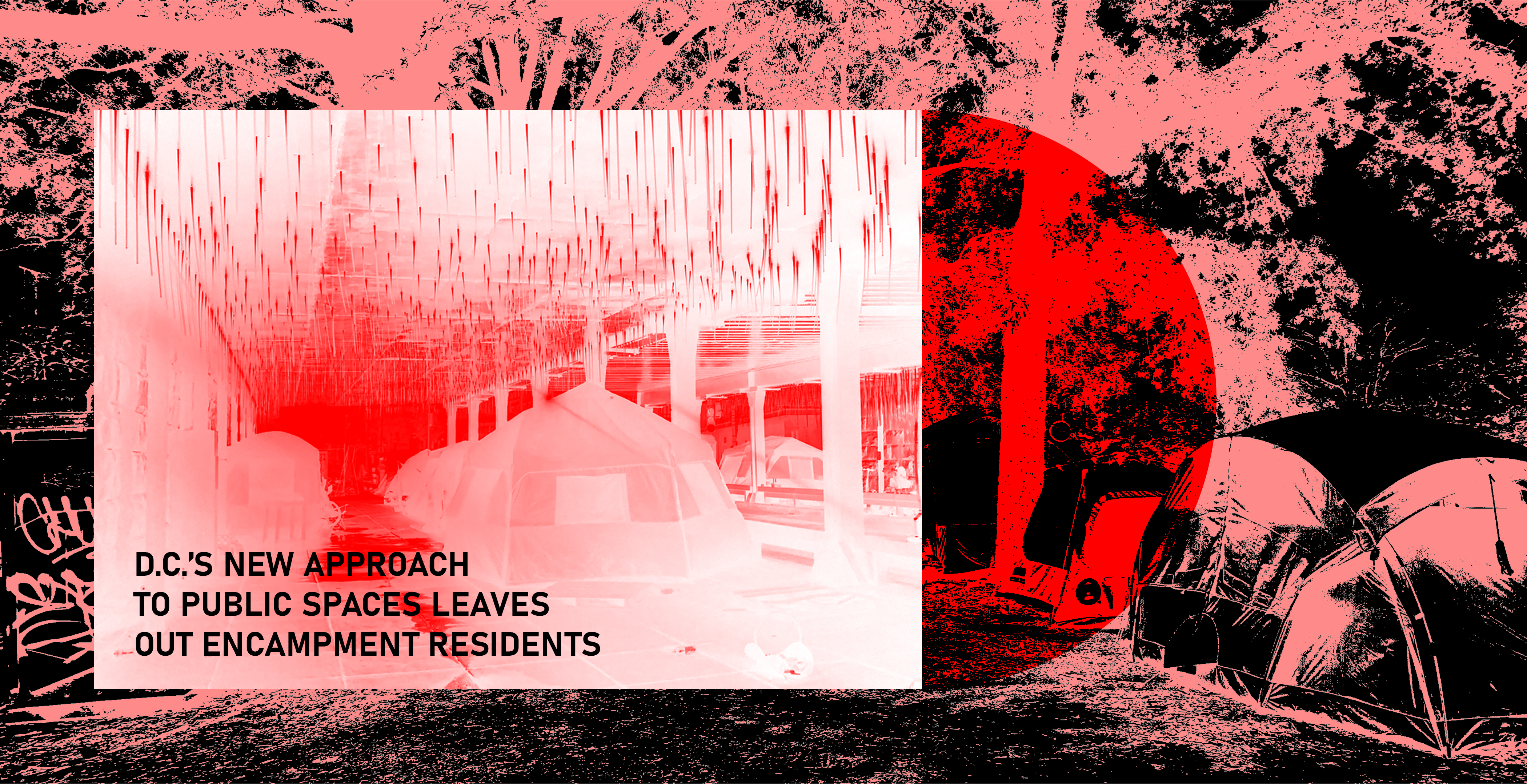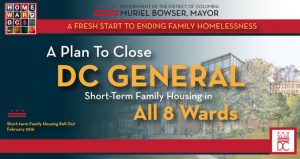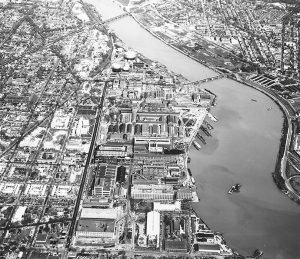“Are you here to help with housing?”
Al asked the question hopefully, approaching a Voice reporting team. At a negative answer, he looked downcast. “I am really looking for housing,” he repeated.
Al is a resident of the L St. NE underpass in D.C.’s Ward 6 NoMa neighborhood, at least for the next few weeks. Afterward, the city will force him to permanently pack his belongings and move to another encampment, unless he can secure assistance from the city.
This is a result of the District’s decision to permanently close three encampments as part of a pilot program that aims to rehouse encampment residents in conjunction with the sites’ closure. While this goal sounds promising, its creation of no-tent zones is likely to further criminalize homelessness, making it literally illegal to live in some public spaces.
D.C.’s Office of the Deputy Mayor for Health and Human Services (DMHHS) announced the approaching permanent closure of NoMa’s M and L St. underpass, New Jersey Av. and O St. NW, and E and 20th St. NW encampments, banning the repitching of any tents in the area after their fall closure dates. An upcoming closure of Franklin Park, another common location for encampments, has also been announced without an effective date.
The city’s attempts to close the encampments foreground a question the city has argued over for years: Who gets to use D.C.’s public spaces?
Encampments are groups of tents or shelters set up in public places, often parks and underpasses, that serve as refuge for homeless populations. There are approximately 119 encampments in the District, of which NoMa is one of the largest. Because housing insecurity can be caused by structural poverty and rising traditional housing costs without sufficient policy solutions, residents might live in encampments for years, and the groups can become communities, often with known neighbors and mutually- agreed-upon rules. While less than 10 percent of those experiencing homelessness in D.C. live in encampments, the sites make homelessness, poverty, and racial disparities visible, and thus often draw criticism.
Encampment “cleanups,” run by DMHHS, respond to this criticism with regular tent site visits to clean the areas. Encampment cleanups range from trash-only to full, where residents are required to remove all their belongings from a posted area. If residents do not clear the area, city workers accompanied by DMHHS staff and law enforcement throw their belongings away.
To prevent spreading COVID-19 and displacing residents, as per the Center for Disease Control (CDC) guidelines, encampment cleanups were all trash-only during the pandemic. This summer, however, full cleanups resumed.
These cleanups, even if temporary, are frustrating for encampment residents. For Leon, a resident at the E St. and 20th encampment, the cleanups are stressful. “It’s emotionally challenging, physically challenging. Once you’ve got your stuff laid out again, you feel good,” Leon said.
Under the new program, moving one’s belongings back to the site would be illegal. The NoMa encampment is scheduled to permanently close on Sept. 27; the other two encampments are expected to close by early November. DMHHS’s pilot program is paired with attempts to move residents into permanent supportive housing (PSH), which offers individuals experiencing homelessness housing without an expiration date. The program, however, relies on housing vouchers, and their supply is limited due to funding.
For Al, the city’s decision means he needs to find a new place to live—and fast. While he has watched various residents of the NoMa encampment move into PSH, he and the remaining neighbors are still waiting. “This area was jam-packed,” Al said, noting that many of his former neighbors had already moved.
Sam is one of those neighbors still residing in the NoMa encampment. According to him, city officials and police came by the encampment to announce the closure. “They’re trying to get vouchers for people,” Sam said. He, like Al, is waiting for a voucher in order to secure PSH once the encampment is closed.
According to an information sheet circulated by Mayor Muriel Bowser’s office, the pilot program will involve creating lists of residents at each location, increasing outreach, and aiding residents in completing housing voucher applications. At a Sept. 9 Advisory Neighborhood Commission (ANC) meeting, Deputy Chief of Staff for DMHHS Jessica Smith said more than 90 percent of encampment residents will be eligible for PSH. Increased resources flowing to the Department of Behavioral Health will make accelerating PSH possible. The initial program will cost about $4 million.
“Our hope that is all of the residents who are living in the encampments take us up on the offer,” Wayne Turnage, D.C.’s deputy mayor of Health and Human Services, told News4.
Some residents, however, like Al and Sam, have yet to secure PSH. According to Reginald Black, a constituent representative for the Interagency Council on Homelessness, there is already high demand for housing vouchers from the Pandemic Emergency Program for Medically Vulnerable (PEP-V) residents, medically vulnerable individuals experiencing homelessness who are sheltering in hotels during the pandemic. As of Aug. 18, PEP-V hotels still housed 522 people who need to move into PSH before funding ends Nov. 30. Emergency housing vouchers would not provide for the entire PEP-V community, let alone residents in closing encampments.
“We know that combined with the PEP-V population, we are going to basically exhaust our emergency housing vouchers,” Black said.
Though placement normally takes up to nine months, the city aimed to place residents of the NoMa encampments in PSH by Sept. 20, and residents of the two other encampments before they close in November. “I just don’t understand what is new about this process that would quickly house people,” Black said.
“I hope they’re not selling dreams,” Sam said in regards to the program’s plan to pair residents with PSH.
Even if PSH is an option, not all residents of encampments are looking to move. Tim, who has lived at the E St. encampment for five years, is familiar with PSH—he has even toured apartments before—but didn’t feel comfortable leaving his tent site.
“They showed me two places. I don’t want to live there,” Tim said. Though the plan states that officials will help relocate residents like Tim who aren’t seeking or eligible for PSH, it’s unclear what that will look like, and this relocation will disrupt the tight-knit communities already formed in some encampments. If he has to leave, Tim said, “I’ll just go back to the way I was doing it.”
Encampments have always been a source of conflict. Visible homelessness is stigmatized, and wealthy residents across the U.S. often object to the evidence of inequality, pushing the government to force those experiencing homelessness out of sight. This inequality is also
racialized, with people of color experiencing homelessness at far higher rates than white people due to centuries of systemic discrimination in education, housing policy, and health care that leave families of color with a far weaker safety net. When residents living in public spaces are predominantly people of color, especially Black residents in predominantly white neighborhoods, criticisms of the encampments are often not just reactions to visible poverty, but visible Blackness.
2020 marked the first time since data collection on the homeless population began that more people experiencing homelessness were unsheltered—sleeping in encampments, doorways, or parks—than sheltered. COVID-19 played a part, making shelters dangerous places to be: according to the D.C. Department of Human Services, 587 people living in shelters have tested positive for COVID-19, and at least 25 people experiencing homelessness have died from it.
Now, the city has begun testing permanent closures. In August, two parks in Northwest D.C. were closed for “rehabilitation,” clearing the encampments located there. In June, the city almost cleared an encampment to make more space for a “streatery.” Encampment cleanups have also increased in the last year.
At the E St. encampment, where closure was scheduled to begin Sept. 20, neighbors are exchanging uncertain information about the permanent closure of the encampment. As of Sept. 17, no signs around the encampment indicated a date for permanent closure, and no residents interviewed by the Voice had been directly approached by city officials.
According to Leon, a city official informed some residents at the encampment of the closure. “For a minute I felt shaken. I’ve only been back two weeks. Before I was here 12 or 18 months. I guess it’s just like they say—roll with the punches,” Leon said.
In January 2020, the District cleared a NoMa K St. encampment, declaring the sidewalks were “pedestrian passageways” that could not be blocked. Smith, from DMHHS, explained in a Sept. 9 ANC meeting that the newly announced closures are due to “risk” the encampments pose to residents and passers-by.
While DMHHS cites public health and safety concerns as the reason for the closure, Freedom of Information Requests (FOIAs) point to a more complicated story of neighborhood aversion to encampments.
Emails to D.C. Councilmember Charles Allen and ANC commissioners in the area of Allen Park, one of the three sites being closed this month, reveal that housed residents had been complaining about the encampment since December 2019. Neighborhood residents were adamant that “something should be done” about allegations of petty theft, drugs, and trash in the encampment. According to the emails, an encampment response team engaged the site this spring, connecting residents to services and cleaning up biohazards and propane tanks.
The FOIA request also revealed that residents of other D.C. neighborhoods report new encampments in their areas, often asking for their removal. Government officials generally responded by engaging the encampment and sending updates to housed residents, though they did not promise removal. The DMMHS’s page on encampments explicitly encourages residents to report new groups of tents to the government.
Sam, a resident at the NoMa encampment, felt that the encampment closure was probably due to people’s unhappiness with the tents. “It’s an eyesore, and I understand: People paying taxes don’t want to see it.”
According to Black, though, the zoned-off pedestrian passageways cited as the reason for the K St. closure are unnecessary. Black pointed out that none of the members of the Fairness Coalition have had to walk in the street while offering PPE gear to encampment residents. “There is no clear definition of what [a pedestrian passageway] is. There is no legislation, there are no regulations.”
Black thinks it is less of an issue of pedestrian safety, and more a judgement of people experiencing homelessness. “I think they are moving to close these encampments because some neighbors feel uncomfortable about having to traverse a walkway in front of people who obviously are poor.”
ANC and D.C. Council representatives for each encampment did not respond to requests for comment.
There is also often a racial disparity between those living in encampments and those who live around them. While D.C. is 47 percent Black, Black people make up 87 percent of those experiencing homelessness, due to a range of factors that cause structural poverty, including a lack of generational wealth and discrimination in home ownership. In what was previously the most gentrified city in the nation, Black residents are also being pushed out by higher prices at a much faster rate, even as gentrification worsens. NoMa and Foggy Bottom, where the encampments being closed are located, are both whiter on average than the rest of the city.
The pilot program is paired with “a significantly higher level of trash collection and restorative cleaning at the pilot sites.” This aspect criminalizes homelessness by making tents, which are the only shelter for many residents experiencing homelessness, illegal.
Dan Brown, a resident at the E St. and 20th encampment, explained that the land he lives on is public space. While people might not want the tents there, he wonders where they would suggest residents go. “They’re making mandates without offering solutions. They’re just going to push it out of the District into Maryland or Virginia,” he said. “Everyone wants to push the issue further out.”
“The criticism comes in because of the level of public notice,” Black said. “A lot of this pushback comes because people are scared, they don’t know what’s going on. And when you try to calmly get some information, you don’t get any.”
While Black acknowledges that encampments are not ideal living situations, the alternative if people cannot access housing is often worse.
“It’s apparent that the way the system works now, when you close an encampment down, even outside of a pandemic, you destabilize the community support network and safety net that that person has,” he said.
Leon shared a similar sentiment. “I like being in Foggy Bottom—I get to know it more intimately. It’s heartfelt. I get to do it myself. Maybe it’s like this,” he said, gesturing towards the encampment, “but I get to do it too.” While he’s not opposed to PSH, he made it clear that moving his tent anywhere else would be like leaving home.
For many residents, PSH is an imperfect substitute for a permanent solution—affordable housing. “It’s the cost of living. Prices have been going up the last 20 years,” Brown said.
D.C. residents need to make around $130,000 a year to comfortably afford a two-bedroom apartment (with an average rent of $3,100 a month) without being “cost- burdened” by rent. Households who spend more than 30 percent of their income on housing are classified as cost- burdened, while those who spend more than 50 percent of their income on housing are severely cost-burdened.
The problem is clear: The median household income for the District is $91,414, but only $46,201 and $83,170 for Black and Latino residents, respectively. At any of those incomes, a median family looking to rent a two-bedroom apartment would be cost-burdened by rent, and severely cost-burdened if Black. About a quarter of households don’t make enough to cover average rent at all, bringing in under $36,000 a year. This is why, Brown said, some people are choosing to stay in encampments, knowing they have some money to spend, rather than dedicating a whole paycheck towards housing.
“Homelessness is an independent issue. People assume all homelessness is drug, alcohol addiction. That’s just not true,” Brown said.
“People assume so much about homelessness,” Brown continued. He pointed to structural barriers that keep him and his neighbors in their tents: struggles to access government-issued IDs, gain employment without an address, and secure proper mental health care without
insurance. Up against those daily fights, assumptions about why encampments are taking up public space range from misguided to hurtful.
“People need to be less judgmental and more compassionate,” Brown said. “People don’t ask themselves what if they lost everything, and they’re not prepared for it.”





